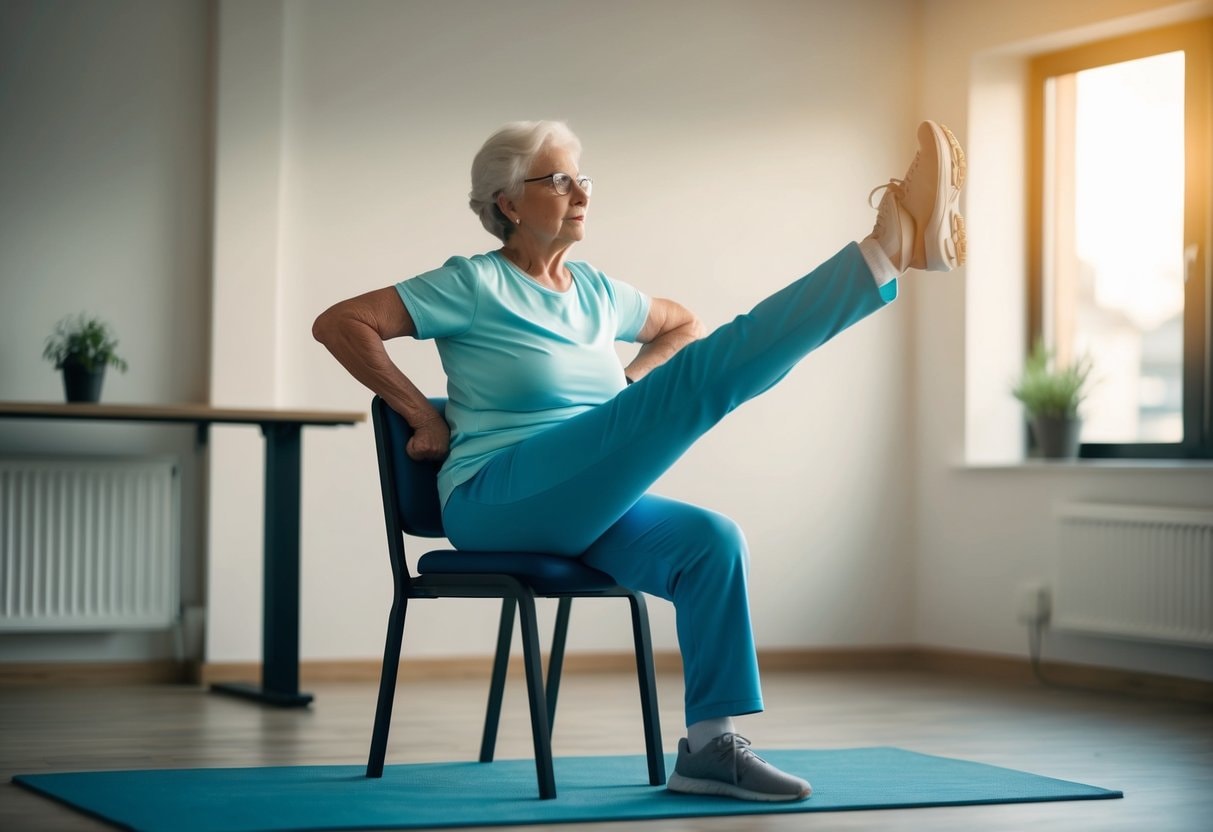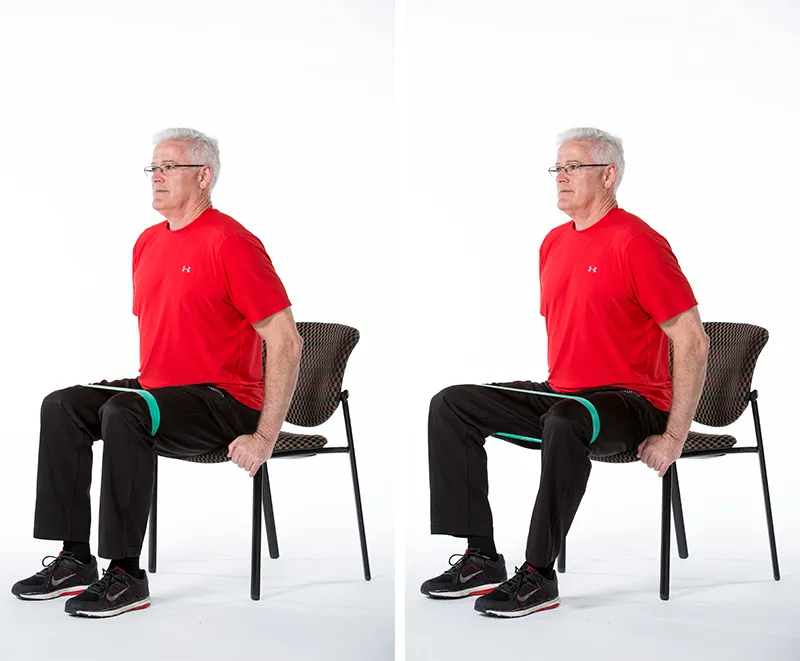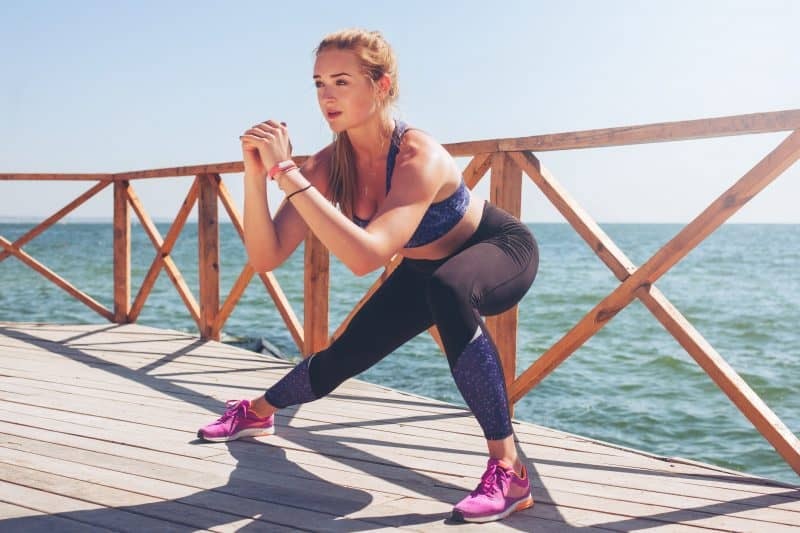Isometric leg exercises for seniors to improve mobility are a great way to enhance movement without stressing the joints. These exercises involve holding positions that strengthen muscles, boost stability, and improve flexibility for seniors looking to maintain independence and move easily, as well as isometric leg workouts that offer a safe and effective approach to staying active.
By focusing on low-impact movements, isometric exercises can help build strength and balance, which are crucial for everyday activities. Whether you aim to regain flexibility or simply maintain an active lifestyle, these exercises provide lasting benefits. Let’s explore how isometric leg exercises can improve mobility and keep you moving confidently.
Isometric Leg Exercises for Seniors to Improve Mobility: Easy Ways to Boost Strength and Balance at Home

As we age, staying active becomes more important than ever. Isometric leg exercises offer a great way for seniors to boost strength and mobility without putting too much strain on their joints. These exercises involve holding still positions, which can help build muscle and improve balance. Isometric leg exercises can help seniors improve their mobility, strength, and balance. They’re easy to do at home and don’t need much equipment.
You can start with simple moves like wall sits or leg raises and work up to more challenging exercises as you get stronger. Regular practice of these exercises can make everyday tasks easier. Things like climbing stairs, getting up from chairs, and walking longer distances can become less of a struggle. Plus, these exercises can help prevent falls, which is important for older adults.
Key Takeaways
- Isometric leg exercises are gentle on joints and can improve strength and balance.
- You can do these exercises at home with little to no equipment.
- Regular practice can make daily activities easier and help prevent falls.
Benefits of Isometric Leg Exercises for Seniors
Isometric leg exercises for seniors to improve mobility can greatly help seniors stay active and mobile. They make your legs stronger without putting too much stress on your joints. These isometric leg exercises for seniors to improve mobility also help you keep your balance and move around more easily.
Improving Balance and Stability
Isometric leg exercises can boost your balance and stability. When you do these exercises, you train your muscles to work together. This helps you stand steady and move with more confidence. Try this simple exercise:
- Stand behind a chair.
- Hold onto the back for support.
- Lift one foot slightly off the ground.
- Hold for 10 seconds.
- Switch feet and repeat.
Do this a few times each day. You’ll soon notice you feel more stable when walking or standing.
Enhancing Joint Health
Your joints can stay healthy with isometric exercises. These exercises don’t put much pressure on your knees, hips, or ankles. This makes them great if you have sore or stiff joints. Isometric exercises help build and keep muscles strong. Strong muscles around your joints give them better support. This can ease pain and help you move more freely. A good exercise for joint health is the wall sit:
- Lean against a wall.
- Slowly slide down until your knees are bent.
- Hold this position for 20-30 seconds.
- Slowly stand back up.
Boosting Leg Strength without Strain
You can make your legs stronger without putting too much stress on them. Isometric exercises let you work your muscles hard while staying in one spot. This is perfect if you find it hard to do other types of exercise. Try this exercise to build leg strength:
- Sit in a chair with your back straight.
- Lift one leg out in front of you.
- Hold for 10 seconds.
- Lower your leg slowly.
- Do the same with your other leg.
Do this 5-10 times for each leg. You’ll feel your muscles working, but it won’t be too hard on your body. Over time, you’ll notice your legs getting stronger. This can help you walk better and do daily tasks more easily.
Essential Safety Tips

Safety is key when doing Isometric Leg Exercises For Seniors To Improve Mobility. These tips will help you stay safe and benefit most from your workouts.
Proper Alignment and Posture
Good form is crucial for isometric exercises. Keep your back straight and shoulders relaxed. When standing, place your feet hip-width apart. This gives you a stable base. For seated exercises, sit tall with your feet flat on the floor. Pay attention to your neck position. Keep it in line with your spine to avoid strain. Ask a trainer or physical therapist to check if you’re unsure about your form. They can give you tips to improve. Using a mirror can help you see your posture. This lets you make adjustments as needed.
Starting with Low Resistance
Begin with gentle exercises. You can always increase the intensity later. Try holding positions for just 5-10 seconds at first. Gradually work up to longer holds as you get stronger. Use a chair for support if needed. This can help with balance and make exercises easier. Focus on quality over quantity. It’s better to do a few exercises well than many poorly. Listen to your body. If something feels too hard, back off a bit. As you get stronger, slowly increase the challenge. You might hold positions longer or try more difficult exercises.
Knowing When to Stop
Pay attention to how you feel during and after exercises. Some muscle fatigue is normal, but pain is not. Stop if you feel sharp pain, dizziness, or shortness of breath. These could be signs something’s wrong. Take breaks when you need them. It’s okay to rest between exercises. Don’t push through extreme fatigue. This can lead to injury. If you have ongoing pain or discomfort, talk to your doctor. They can help figure out what’s causing it.
Getting Started with Isometrics

Isometric leg exercises for seniors to improve mobility are great for building strength and enhancing overall movement. They’re easy to do at home and don’t require special equipment. Let’s look at how to start with a warm-up and learn about isometric contractions to make the most of these effective exercises.
Warm-Up Exercises
Before you begin isometric leg exercises, it’s important to warm up. Start with gentle movements to get your blood flowing. Try marching in place for 1-2 minutes. This wakes up your leg muscles. Next, do some ankle circles. Sit in a chair and lift one foot off the ground. Draw circles with your toes five times in each direction. Switch feet and repeat. Standing heel raises are another good warm-up. Hold onto a chair for balance. Slowly rise on your toes, then lower back down. Do this ten times.
Understanding Isometric Contraction
Isometric contraction happens when you tense a muscle without moving the joint. Think of pushing against a wall. Your muscles work hard, but your arm doesn’t move. You might hold a squat position or press your foot against a fixed object for leg isometrics. The key is to squeeze your muscles and hold the position. Start with short holds of 5-10 seconds. As you get stronger, you can hold longer. Aim for 3-5 repetitions of each exercise. Remember to breathe normally during the hold. Isometric exercises are safe for most seniors. Always listen to your body and stop if you feel pain.
Did you Know?
Seniors can benefit from various isometric leg exercises to improve mobility and strength. These exercises can be done safely while seated, standing, or in bed.
Isometric Leg Exercises For Seniors To Improve Mobility: Key Isometric Leg Exercises
Isometric leg exercises can help seniors build strength and improve mobility. These exercises involve holding static positions to engage muscles without joint movement. Let’s look at three effective isometric leg exercises for seniors.
Wall Sits for Quadriceps
Wall sits are great for strengthening your thighs. Here’s how to do them:
- Stand with your back against a wall.
- Slowly slide down until your knees are at a 90-degree angle.
- Hold this position for 10-30 seconds.
- Gradually work up to holding for 1 minute.
Start with 2-3 sets and increase as you get stronger. Keep your back flat against the wall and your knees aligned with your ankles. If you need support, you can place a chair nearby. Wall sits help build endurance in your leg muscles and improve stability.
Seated Leg Presses
Seated leg presses are a safe way to build leg strength. You can do these in a chair:
- Sit in a sturdy chair with your feet flat on the floor.
- Lift one foot slightly off the ground.
- Press your heel into an imaginary surface in front of you.
- Hold for 5-10 seconds, then release.
- Repeat with the other leg.
Do 10-15 reps per leg. As you get stronger, you can increase the hold time. This exercise targets your quads, hamstrings, and glutes. It’s important to keep your back straight and avoid locking your knee. If you feel any pain, stop the exercise.
Standing Calf Raises
Standing calf raises help improve balance and strengthen your lower legs. Here’s how to do them:
- Stand behind a chair or counter for support.
- Slowly rise up onto your toes.
- Hold this position for 5-10 seconds.
- Lower your heels back to the ground.
Start with 10-15 reps and gradually increase. You can also try doing one leg at a time for an extra challenge. Calf raises are great for improving ankle stability and preventing falls. Remember to move slowly and control throughout the exercise. If you have balance issues, always have someone nearby when trying new exercises.
Incorporating Equipment

Adding simple tools to your isometric leg exercises can boost their effectiveness. Equipment like resistance bands and ankle weights can make workouts more challenging and help build strength faster.
Using Resistance Bands
Resistance bands are great for isometric leg exercises. They’re cheap, portable, and easy to use. You can wrap a band around your thighs or ankles to add tension to exercises like wall sits or leg raises. To use a band for wall sits:
- Loop it around your thighs.
- Slide down the wall into a sitting position.
- Push your knees outward against the band.
- Hold for 10-30 seconds.
For leg raises with a band:
- Lie on your side.
- Loop the band around your ankles.
- Lift your top leg against the band’s resistance.
- Hold for 5-10 seconds.
Start with light resistance and work your way up. Always keep the band tight to maintain tension throughout the exercise.
Exercising with Ankle Weights
Ankle weights can make your leg exercises more challenging. They’re good for building strength in your thighs, calves, and hips. Start with light weights of 1-2 pounds and increase slowly as you get stronger. Try this isometric exercise with ankle weights:
- Stand on one leg.
- Lift your other leg to the side.
- Hold for 10-15 seconds.
- Lower and repeat.
You can also use ankle weights for seated leg extensions. Sit in a chair, lift one leg straight out, and hold for 10 seconds. This works your thigh muscles. Remember to strap the weights on securely. Don’t use them if you have joint pain or balance issues. Always check with your doctor before starting a new exercise routine.
Progressing in Your Routine

You’ll want to make your Isometric Leg Exercises For Seniors To Improve Mobility more challenging as you get stronger. This will help you keep improving your leg strength and mobility by incorporating longer holds and varied positions into your routine.
Increasing Hold Time
Start by holding each isometric exercise for 10 seconds. When this feels easy, try holding for 15 seconds. Slowly work your way up to 30-second holds. Remember to breathe normally during the hold. It’s okay to reduce the time if you feel shaky or unstable.
Try to increase your hold time by 5 seconds each week. This gradual approach helps prevent injury and builds endurance. Some exercises may be harder to hold than others. That’s normal! Focus on increasing the time for exercises you find easier first.
Adding More Repetitions
Begin with five repetitions of each exercise. As you get stronger, add one extra rep each week. Your goal is to work up to 10-15 reps per exercise. This helps build endurance and strength in your leg muscles. If adding reps feels too hard, try this:
- Do three sets of 5 reps.
- Rest for 30 seconds between sets.
- Gradually increase to 3 sets of 8 reps.
Listen to your body. If you feel pain or extreme fatigue, take a break or reduce the number of reps. Mix it up! Try doing fewer reps with longer hold times one day and more reps with shorter holds the next.
Staying Motivated
Keeping up with isometric leg exercises takes dedication. You can stay on track by setting clear goals and monitoring your progress. These strategies will help you stay motivated and see real improvements in your mobility over time.
Setting Achievable Goals
Start by setting small, realistic goals for your isometric leg exercises for seniors to improve your mobility routine. You might aim to do exercises for 10 minutes three times a week. As you build strength, gradually increase your time or add new exercises. Write down your goals and put them somewhere visible. This will remind you of what you’re working towards in your journey to enhance mobility and strength.
You can also tell a friend or family member about your goals for extra support. Remember to celebrate your wins, no matter how small. Did you hold a wall sit for 5 seconds longer? That’s progress! Recognizing these achievements will boost your motivation to keep going.
Tracking Progress
Keep a simple exercise log to track your workouts. Note which exercises you do, how long you hold each position, and how you feel afterward. You can use a notebook or a smartphone app – whatever works best for you. Take photos or videos of yourself doing the exercises every few weeks. This visual record can show your form and stability improvements that you might not notice daily.
Measure your progress in daily activities, too. Can you stand up from a chair more easily? Are you walking further without getting tired? These real-life improvements are great motivators. Consider finding an exercise buddy. You can check in with each other, share progress, and offer encouragement. Having someone to be accountable to can help you stick with your routine.
Complementing Isometric Exercises

Isometric exercises are great but work best when paired with other activities. A well-rounded fitness plan helps you stay healthy and mobile as you age.
Integrating Aerobic Activities
Adding aerobic exercises to your routine can boost your heart health and stamina. Try low-impact activities that are easy on your joints, including isometric leg exercises for seniors to improve mobility. Walking is a simple way to get moving; aim for 30 minutes a day, five days a week. Swimming and water aerobics are excellent choices, too, as the water supports your body, making movement easier. Start with 15-minute sessions and slowly increase your time to maximize benefits.
Cycling outdoors or on a stationary bike is another good option. It strengthens your legs without putting stress on your knees. Begin with 10-minute rides and work up to longer sessions. Remember to start slow and listen to your body. Gradually increase the intensity and duration of your aerobic workouts as you get stronger.
Adding Flexibility and Balance Exercises
Stretching and balancing work can help prevent falls and keep you limber. Try gentle yoga or tai chi classes designed for seniors. These improve your mobility and stability. Stretching exercises can be done daily. Focus on major muscle groups like your calves, thighs, hips, and lower back. Hold each stretch for 10-30 seconds without bouncing.
For balance, try standing on one foot while holding onto a chair. Start with 10 seconds and work up to 30 seconds on each leg. As you improve, try it without holding on. Heel-to-toe walks are another great balance exercise. Take 20 steps, placing the heel of one foot directly in front of the toes of your other foot. Always do these exercises in a safe environment. Use a chair or wall for support if needed.
Cool Down and Recovery
After doing isometric leg exercises for seniors to improve mobility, it’s important to cool down and let your body recover. This helps your muscles relax and prevents stiffness. Start with some gentle stretches for your legs. Hold each stretch for 15-30 seconds without bouncing. Here are some easy cool-down exercises you can try:
- Toe touches (seated or standing).
- The calf stretches against a wall.
- Gentle leg swings.
- Knee hugs while lying down.
Deep breathing can also help you relax. Take slow, deep breaths for 5-10 minutes. This will help lower your heart rate and make you feel calmer. Don’t forget to drink water after your workout. Staying hydrated helps your muscles recover faster.
If you feel sore the next day, that’s normal. Light activity, like a short walk, can help ease the soreness. You can also try using a warm compress on tight muscles. Remember to listen to your body. If something hurts, stop and rest. With time and practice, you’ll get stronger and more flexible.
Here’s an additional video about leg strengthening for seniors.
By: SpineCare Decompression and Chiropractic Center
Empowering Movement: Isometric Leg Exercises for Improved Mobility in Seniors
Isometric leg exercises offer a valuable means for seniors to improve mobility, strength, and balance without putting excessive strain on their joints. By incorporating these gentle yet effective exercises into a routine, seniors can enhance their physical well-being and independence.
The versatility of isometric exercises allows for practice in various settings, whether at home or seated. As seniors progress in their strength, they can gradually increase the intensity and duration of their workouts, ensuring continued improvement and engagement. Ultimately, making isometric leg exercises a part of a daily routine can lead to significant gains in confidence and ease of movement, helping seniors enjoy a more active and fulfilling lifestyle.
Frequently Asked Questions
What Are Some Safe Seated Isometric Exercises for Seniors to Enhance Leg Strength?
Chair squats are great for seniors to build leg strength. Sit on the edge of a chair with your feet flat on the floor. Try to stand up without using your hands, but stop halfway. Hold this position for 5-10 seconds. You can also do leg extensions while seated. Straighten one leg before you and hold it for 5-10 seconds. Lower it slowly and repeat with the other leg.
How Do Isometric Leg Exercises Contribute to Improving Mobility in Seniors?
Isometric exercises help build strength and stability in your legs. This can lead to better balance and easier movement in daily activities. These exercises also improve joint flexibility and muscle endurance. This means you’ll be able to walk, climb stairs, and move around more easily.
Which Leg Strengthening Exercises Can Seniors Perform While in Bed for Better Mobility?
You can do leg raises while lying down. Lift one leg a few inches off the bed and hold for 5-10 seconds. Lower it slowly and repeat with the other leg. Another option is to do ankle rotations. Point and flex your feet, then make circular motions with your ankles. This helps improve circulation and flexibility.
Revitalize Your Fitness Journey Beyond 55!
Hello, fitness lovers! Discover the secrets to vitality and well-being with Fit After 55! Whether you’re an experienced athlete or just starting out, our platform serves as your comprehensive resource for holistic health. From establishing realistic goals to celebrating achievements, we’re here to assist you in reimagining what it means to thrive after 55. Visit our website and join our Facebook page today to unleash your full potential with Fit After 55!
Read More About Isometric Exercises For Seniors
Isometric Exercises For Seniors: Safety Tips & Precautions
Benefits Of Isometric Exercises For Older Adults: Boosting Strength
Isometric Exercises For Seniors: Gentle Strength Training
Strength Training Improves Immune System in Seniors: The Benefits of Exercise

